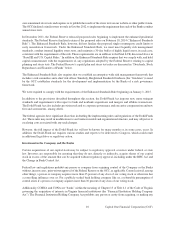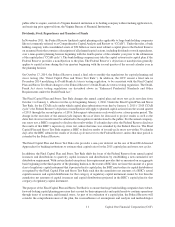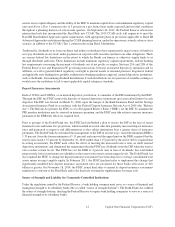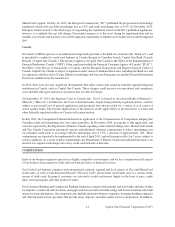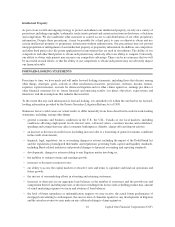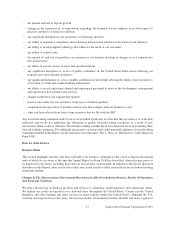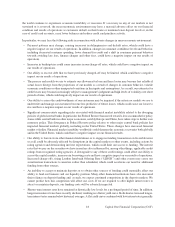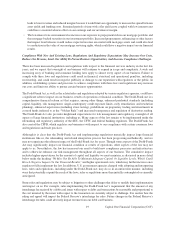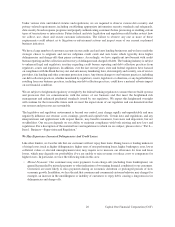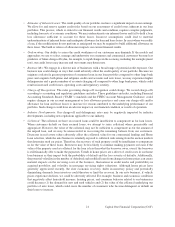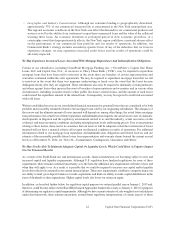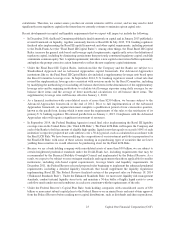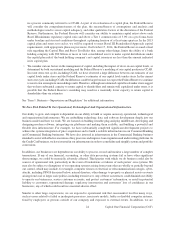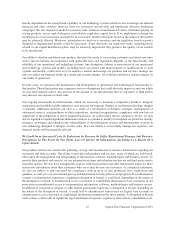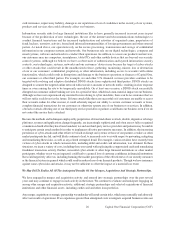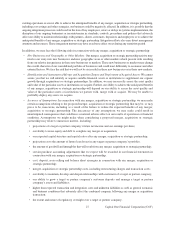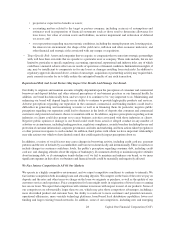Capital One 2014 Annual Report Download - page 42
Download and view the complete annual report
Please find page 42 of the 2014 Capital One annual report below. You can navigate through the pages in the report by either clicking on the pages listed below, or by using the keyword search tool below to find specific information within the annual report.Under various state and federal statutes and regulations, we are required to observe various data security and
privacy-related requirements, including establishing appropriate information security standards and safeguards,
data security breach response programs and properly authenticating customers before processing or enabling certain
types of transactions or interactions. Future federal and state legislation and regulation could further restrict how
we collect, use, share and secure customer information. The failure to observe any one or more of these
requirements could subject us to litigation or enforcement actions and impact some of our current or planned
business initiatives.
We have a large number of customer accounts in our credit card and auto lending businesses and we have made the
strategic choice to originate and service subprime credit cards and auto loans which typically have higher
delinquencies and charge-offs than prime customers. Accordingly, we have significant involvement with credit
bureau reporting and the collection and recovery of delinquent and charged off debt. The banking industry is subject
to enhanced legal and regulatory scrutiny regarding credit bureau reporting and debt collection practices from
regulators, courts and legislators. In addition, over the last several years, state and federal regulators have focused
on compliance with the Bank Secrecy Act and anti-money laundering laws, data integrity and security, use of service
providers, fair lending and other consumer protection issues. Any future changes to our business practices, including
our debt collection practices, whether mandated by regulators, courts, legislators or otherwise, or any legal liabilities
resulting from our business practices, including our debt collection practices, could have a material adverse impact
on our financial condition.
We are subject to heightened regulatory oversight by the federal banking regulators to ensure that we build systems
and processes that are commensurate with the nature of our business and that meet the heightened risk
management and enhanced prudential standards issued by our regulators. We expect this heightened oversight
will continue for the foreseeable future until we meet the expectations of our regulators and can demonstrate that
our systems and processes are sustainable.
The legislative and regulatory environment is beyond our control, may change rapidly and unpredictably and may
negatively influence our revenue, costs, earnings, growth and capital levels. Certain laws and regulations, and any
interpretations and applications with respect thereto, may benefit consumers, borrowers and depositors, but not
stockholders. Our success depends on our ability to maintain compliance with both existing and new laws and
regulations. For a description of the material laws and regulations to which we are subject, please refer to “Part I—
Item 1. Business—Supervision and Regulation.”
We May Experience Increased Delinquencies And Credit Losses.
Like other lenders, we face the risk that our customers will not repay their loans. Rising losses or leading indicators
of rising losses (such as higher delinquencies, higher rates of non-performing loans, higher bankruptcy rates, lower
collateral values or elevated unemployment rates) may require us to increase our allowance for loan and lease
losses, which may degrade our profitability if we are unable to raise revenue or reduce costs to compensate for
higher losses. In particular, we face the following risks in this area:
•Missed Payments: Our customers may miss payments. Loan charge-offs (including from bankruptcies) are
generally preceded by missed payments or other indications of worsening financial condition for our customers.
Customers are more likely to miss payments during an economic downturn or prolonged periods of slow
economic growth. In addition, we face the risk that consumer and commercial customer behavior may change (for
example, an increase in the unwillingness or inability of customers to repay debt), causing a long-term rise in
delinquencies and charge-offs.
20 Capital One Financial Corporation (COF)


